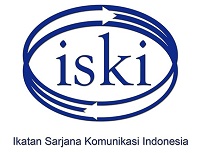Pengaruh Motif Selfie Terhadap Keterbukaan Diri Generasi Milenial
Abstract
Keywords
Full Text:
PDFReferences
Aditya, R. (2015). Pengaruh Media Sosial Instagram Terhadap Minat Fotografi pada Komunitas Fotografi Pekanbaru. Jurnal Online Mahasiswa FISIP, Vol 2, No.2, 1-14.
Alblooshi, A. (2015). Self-Esteem Levels & Selfies: The Relationship between Self-Esteem Levels and the Number of Selfies People Take and Post, and the Uses and Gratifications of Taking and Posting Selfie. Thesis Middle Tennessee State University.
APJII.com (2019, 05 23). Retrieved from Asosiasi Penyelenggara Jasa Internet Indonesia: https://apjii.or.id/
Atmoko, B. D. (2012). Instagram Handbook. Jakarta: Mediakita.
Azwar, S. (2004). Metode Penelitian. Yogyakarta: Pustaka Pelajar.
Detik.com. (2019, 05 20). Retrieved from Detik.com: https://news.detik.com/ berita/d-3204331/7-selfie-berujungmaut-yang-terjadi-di-indonesiasepanjang-2016
Devito, J. A. (2011). Komunikasi Antar Manusia (Edisi Kelima). Tangerang: Kharisma Publishing Group.
Gainau, M. B. (2009). Keterbukaan diri (self disclosure) siswa dalam perspektif budaya dan implikasinya bagi konseling. Jurnal Ilmiah Widya Warta, Vol 33.
Hadi, S. (1991). Analisa Butir untuk Instrument. Yogyakarta: Andi Offset.
Jennifer Kilber, A. B. (2014). Seven Tips for Managing Generation Y. Journal of Management Policy and Practice vol. 15(4), 81.
Kearney, A. (2018). Uses and Gratification of Posting Selfies on Social Media. Theses, Rochester Institute of Technology.
Kompas.com. (2019, 05 06). Retrieved from https://tekno.kompas.com/ read/2018/06/21/10280037/juni-2018pengguna-aktif-instagram-tembus-1miliar
Kompas.com. (2019, 05 07). Retrieved from Lifestyle: https://lifestyle.kompas. com/read/2018/12/27/142313720/ selfie-di-lokasi-bencana-beri-simpatiatau-pencarian-eksistensi?page=all
Kuniali, S. (2011). Peran Media Sosial di Internet Pada Penerapan Proses Knowledge Management. Jurnal Bina Nusantara Vol 2, No 1, 167-174.
Lister, M. (2009). New Media: A Critical Introduction. London: Routledge.
Lyons, S. (2004). An exploration of generational values in life and at work. ProQuest Dissertations and Theses, 441.
McQuail, D. (2010). McQuail’s Mass Communication Theory 6th Edition. London: Sage Publication.
Neuman, W. L. (2003). Social Research Methods: Qualitative And Quantitative Approaches. Boston: Allyn and Bacon.
Okezone.com. (2019, 05 06). Retrieved from https://techno.okezone.com/ read/2016/01/14/207/1288332/ pengguna-instagram-di-indonesiaterbanyak-mencapai-89
Rakhmat, J. (2004). Metode Penelitian Komunikasi. Bandung: P.T Remaja Rosdakarya.
Richard West, L. H. (2007). Pengantar Teori Komunikasi. Jakarta: Salemba Humanika.
Santoso, S. (2004). SPSS Versi 11.5 Cetakan Kedua. Jakarta: Gramedia.
Sarwono, J. (2006). Metode Penelitian Kuantitatif dan Kualitatif. Yogyakarta: Graha Ilmu.
Statistik, B. P. (2018). Profil Generasi Milenial. Jakarta: Kementerian Pemberdayaan Perempuan dan Perlindungan Anak.
Sugiyono. (2012). Statistic untuk penelitian. Bandung: Alfabeta.
Sugiyono. (2013). Metode Penelitian Kuantitatif Kualitatif dan R & D. Bandung: Alfabeta.
Sugiyono. (2014). Metode Penelitian Kuantitatif Kualitatif dan R & D. Bandung: Alfabeta.
Valerie Barker, N. S. (2019). This Is Who I Am: The Selfie as a Personal and Social Identity Marker. International Journal of Communication 13, 1143-1166.
Williamson, P. (2017). Me, My "Selfie" and I: A Survey of Self-disclosure Motivations on Social Media. IAFOR Journal of Cultural Studies, Vol 2-Issue 2.
Zhiying Yue, Z. T. (2015). Me, Myselfie, and I: Individual and Platform Differences in Selfie Taking and Sharing Behaviour. ISBN 978-1-4503-4847-8/17/07.
DOI: https://doi.org/10.29313/mediator.v12i2.5037
Refbacks
- There are currently no refbacks.

This work is licensed under a Creative Commons Attribution 4.0 International License
























